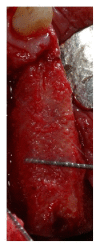Histological Features and Biocompatibility of Bone and Soft Tissue Substitutes in the Atrophic Alveolar Ridge Reconstruction
- PMID: 27022489
- PMCID: PMC4781934
- DOI: 10.1155/2016/3608602
Histological Features and Biocompatibility of Bone and Soft Tissue Substitutes in the Atrophic Alveolar Ridge Reconstruction
Abstract
The reconstruction of the atrophic alveolar ridges for implant placement is today a common procedure in dentistry daily practice. The surgical reconstruction provides for the optimization of the supporting bone for the implants and a restoration of the amount of keratinized gingiva for esthetic and functional reasons. In the past, tissue regeneration has been performed with autogenous bone and free gingival or connective tissue grafts. Nowadays, bone substitutes and specific collagen matrix allow for a complete restoration of the atrophic ridge without invasive harvesting procedures. A maxillary reconstruction of an atrophic ridge by means of tissue substitutes and its histological features are then presented.
Figures













References
-
- Bouri A., Jr., Bissada N., Al-Zahrani M. S., Faddoul F., Nouneh I. Width of keratinized gingiva and the health status of the supporting tissues around dental implants. The International Journal of Oral & Maxillofacial Implants. 2008;23(2):323–326. - PubMed
-
- Cicciù M., Herford A. S., Stoffella E., Cervino G., Cicciù D. Protein-signaled guided bone regeneration using titanium mesh and Rh-BMP2 in oral surgery: a case report involving left mandibular reconstruction after tumor resection. The Open Dentistry Journal. 2012;6(1):51–55. doi: 10.2174/1874210601206010051. - DOI - PMC - PubMed
-
- Yamada S., Shima N., Kitamura H., Sugito H. Effect of porous xenographic bone graft with collagen barrier membrane on periodontal regeneration. International Journal of Periodontics and Restorative Dentistry. 2002;22(4):389–397. - PubMed
LinkOut - more resources
Full Text Sources
Other Literature Sources
Miscellaneous

